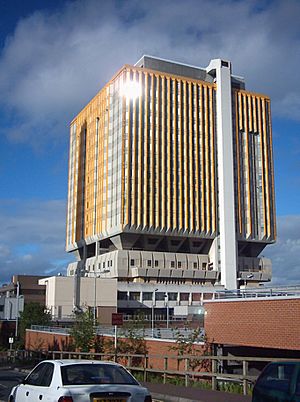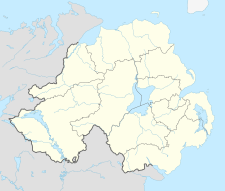Belfast City Hospital facts for kids
Quick facts for kids Belfast City Hospital |
|
|---|---|
| Belfast Health and Social Care Trust | |

The tower at Belfast City Hospital
|
|
| Geography | |
| Location | Lisburn Road, Belfast, Northern Ireland |
| Coordinates | 54°35′15″N 5°56′27″W / 54.58750°N 5.94083°W |
| Organisation | |
| Care system | Health and Social Care in Northern Ireland |
| Hospital type | District General |
| Affiliated university | Queen's University Belfast Ulster University |
| Services | |
| Emergency department | No |
| Beds | 900 |
| History | |
| Founded | 1841 |
The Belfast City Hospital is a very important hospital in Belfast, Northern Ireland. It has 900 beds and is a modern teaching hospital. This means it helps train new doctors and nurses. The hospital's tall, orange tower block stands out in the Belfast skyline. It is the third tallest building in Northern Ireland. The hospital is known for its special care in treating cancer and kidney problems. The Belfast Health and Social Care Trust manages the hospital. It is one of the largest general hospitals in the United Kingdom. In April 2020, during the worldwide coronavirus pandemic, the tower block was used as a special "Nightingale Hospital" to help many patients.
Contents
Hospital History
How the Hospital Started
The Belfast City Hospital began as part of the Belfast Union Workhouse. This was a place for poor people who needed help. It had an infirmary, which is like a small hospital. The workhouse was designed by Charles Lanyon and opened on January 1, 1841. The infirmary was meant for people who were poor and could not get healthcare anywhere else.
Growing as a Workhouse Infirmary
It became hard to keep sick people separate from others in the workhouse. So, the infirmary grew into a larger hospital. Soon, it had over 600 beds. On January 31, 1869, a record 4,252 patients were staying in the Belfast Union Infirmary.
Dr. Thomas Andrews' Role
Dr. Thomas Andrews became a doctor in Edinburgh in 1835. At 26, he was hired to care for the many patients. He was paid £60 each year. Belfast grew very big in Victorian times, with 350,000 people. But the city had problems with poor housing and sewage. This led to at least four outbreaks of a serious illness called Cholera. In January 1847, a new fever hospital opened on the site. It had 159 beds.
The Fever Hospital's Work
In 1849, all patients with fevers were moved to the new fever hospital. This meant the main Belfast General Hospital had fewer beds. But it also meant more surgeries could happen there. The fever hospital treated many diseases. These included cholera, smallpox, tuberculosis, measles, and typhoid. By 1883, the infirmary also took patients with burns and long-term illnesses. There were as many as 1,338 patients at that time.
Hospital Expansion and Nursing
Over the years, the number of nurses grew. Many of them were not formally trained at first. In 1867, there were fifteen paid nurses. In November 1884, Miss Ella Pirrie became the Superintendent and Head Nurse. She knew Florence Nightingale, a famous nurse. In December 1884, Miss Nightingale sent a Christmas gift to Miss Pirrie for the children in the Infirmary.
Soon after Miss Pirrie started, nurses got uniforms. Unpaid female helpers received special aprons. Under Miss Pirrie, nursing training began in Belfast for the first time. The first person, Miss Craig, went to Dublin for a nursing exam. Nurse Craig became Superintendent in 1892. A special unit for new mothers was also started. It grew into the Jubilee Maternity Hospital. This hospital moved into new buildings on the site in 1935.
The National Health Service began in 1948. Three of the hospital's lab assistants were among the last people from the workhouse to work at the hospital. They had no parents and were known as Pauper John, Skipper, and Red Hand Rufus.
In the late 1960s, a doctor named Dimitrios Oreopoulos had a special idea. He arranged for seeds from the Tree of Hippocrates in Kos to be planted at the hospital. This was to celebrate the hospital's planned growth. One of these trees, near Erskine House, grew too big to move. It stayed in place. This tree is now surrounded by modern buildings. It is seen as a peaceful spot and a sign of hope. In 2017, it was voted Northern Ireland's Tree of the Year.
The hospital's tall tower block is 15 storeys high. It is about 76 meters (250 feet) tall. Louis Adair Roche designed it, and it opened in January 1986.
Maternity services moved to the Royal Maternity Hospital in May 2000. The Jubilee Maternity Hospital, which was on the Belfast City Hospital site, then closed.
In February 2003, the hospital was chosen as one of nine main hospitals in Northern Ireland. This was part of a government plan to improve healthcare. A special center for cancer treatment opened in March 2006. It has four wards and 72 beds.
The Accident and Emergency Department closed in 2011. This was due to money problems and not enough staff. Patients needing urgent care now go to the Royal Victoria Hospital or The Mater Infirmorum Hospital.
Teaching and Training
The hospital is a teaching hospital. This means it helps train future doctors. Medical students from Queen's University Belfast come here to learn and gain experience.
COVID-19 Pandemic Response
In April 2020, the world faced the coronavirus pandemic. Because of this, the tower block at Belfast City Hospital was made into a special "Nightingale Hospital." This helped the UK care for many patients who were very sick with COVID-19.


